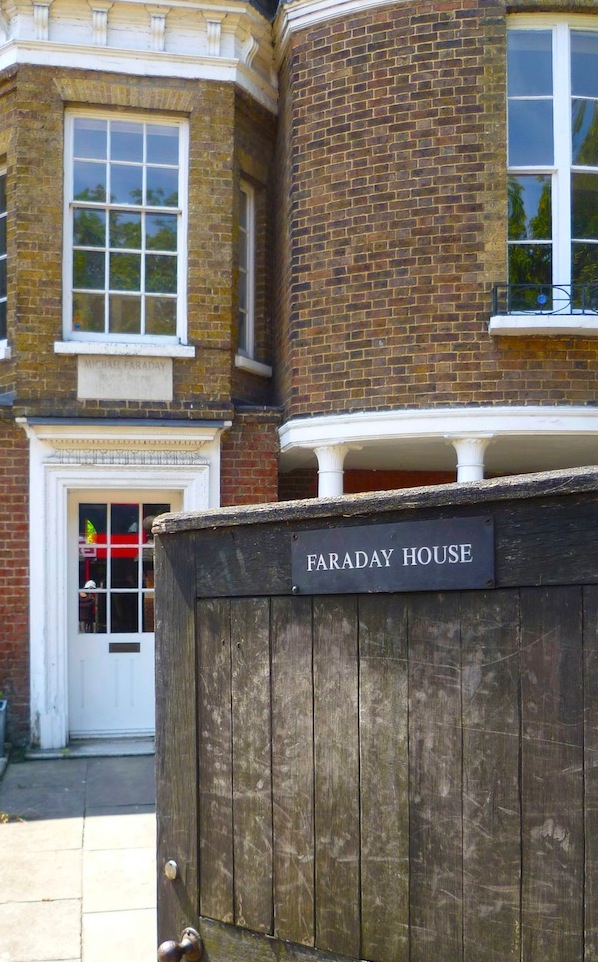
This Grade II listed building was Michael Faraday's last home. It dates from the early eighteenth century, but has some late eighteenth-century additions, as well as later alterations. It is now two separate establishments. Distinguishing features are its central projecting bay, and the impressive first-floor bay to the right, supported by four columns (see listing text). The building faces Hampton Court Green and its garden backs down to the Thames just west of Hampton Court Bridge.


Left: Entrance to Faraday House. Right: View from across the river, just upstream from Hampton Court Bridge. Faraday's house would be hidden by the trees on the left.
As superintendent of the Royal Institution in Albemarle Street, Faraday had previously lived in a flat there with his wife Sarah, but in 1858 Queen Victoria granted the couple this more spacious accommodation at the request of Prince Albert. Faraday was very grateful for this "thoughtful kindness" on Albert's part (qtd. in Jones 393), but worried that he would have to meet the cost of repairing it before moving in. On 20 April that year, he wrote to Prince Albert's secretary, Dr Becker, explaining his position:
My dear Dr. Becker, — I beheve you know all about the extreme kindness shown to me in respect of one of Her Majesty's houses at Hampton Court. I am in a little difficulty about either accepting or declining it. The manner in which it is offered to me is such as would make it grievous to me to decline it, and yet, if it is not improper, I should like to have a few words with you before I finally settle.... (qtd. in Jones 393-94]
However, a short while later, Faraday's mind was set at rest on this score. The repairs were to be paid for, and the house made ready for him, both inside and out, at no cost to himself. He wrote again to Mr Becker in a letter dated 5 May,
I am surprised by the kindness I have received on this occasion, which, in the case of Her Majesty's unsought condescension, astonishes me. I know that your good wishes are with me in this matter, and they are of the greater value to me, as they are free and unsolicited — the spontaneous result of your own kind thought. Whilst enjoying Hampton for a year or two, as I hope to do, pleasant remembrances will be called up on every side. [qtd. in Jones 394]

Illustration showing Faraday's house in the nineteenth century (Jones 393).
In fact, Faraday would live there for nearly ten years. At first, he continued with his professional activities:
Few of those who saw him enjoying the kindness which gave him his house at Hampton Court, or delighting in the beauty of the sunsets from the palace gardens, or rejoicing in the idleness of the summer life in the country, knew that during a great part of this period of his life he was proving by experiment whether his magneto-electric light could be made by Professor Holmes practically useful for lighthouses. [Jones 366]
But in the last few years, his mind failed him. He had experienced problems ever since a sudden severe illness in late 1839 (see James), and now he wrote on one occasion, "Again and again I tear up my letters, for I write nonsense. I cannot spell or write a line continuously. Whether I shall recover — this confusion — do not know. I will not write any more" (qtd. in Jones 450). In April 1867 one of his nieces expressed the pleasure that she and her family took in visiting him: "This is the ninth year that we have had the privilege of seeing spring blossoms in this pleasant comfortable house by the kind invitation of my dear uncle and aunt," she wrote, "they have always said (and I believe it) that their own enjoyment of the house has been heightened by the power it has given them of sharing its benefits with others" (qtd in Jones 473-74); but she was grieved by his "declining, half-paralysed state," and he died soon afterwards, on 26 August of that year, to be laid to rest in Highgate Cemetery, in a simple plot, just as he had wished.
Photographs and text by Jacqueline Banerjee. You may use these images without prior permission for any scholarly or educational purpose as long as you (1) credit the photographer and (2) link your document to this URL in a web document or cite it in a print one. [Click on the images to enlarge them.]
Related Material
- Statue of Faraday at the Royal Institution
- The Royal Institution
- Faraday Giving His Card to Father Thames (Punch 1855)
- Faraday's grave in Highgate Cemetery
Sources
"Faraday House and Cardinal House with Wall and Gatepiers to Street, Richmond upon Thames." British Listed Buildings. Web. 22 September 2016.
James, Frank A. J. L. "Faraday, Michael (1791–1867), natural philosopher, scientific adviser, and Sandemanian." Oxford Dictionary of National Biography. Online ed. Web. 22 September 2016.
Jones, Henry Bence. The Life and Letters of Michael Faraday Vol. 2. 2nd rev. ed. London: Longmans, Green, 1870. Internet Archive. Contributed by Robarts Library, University of Toronto. Web. 22 September 2016.
Created 22 September 2016; last modified 18 August 2023